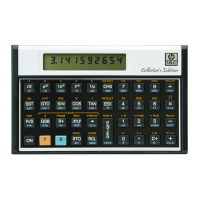248 Appendix E: A Detailed Look at f
Δ =
b
a
δ(x) dx
=
b
a
[0.5 × 10
−n + m(x)
] dx .
This integral is calculated using the samples of δ(x) in roughly the same
ways that the approximation to the integral of the function is calculated
using the samples of (x).
Because Δ is proportional to the factor 10
−n
, the uncertainty of an
approximation changes by about a factor of 10 for each digit specified in
the display format. This will generally not be exact in i or ^
display format, however, because changing the number of digits specified
may require that the function be evaluated at different sample points, so
that δ(x) ~ 10
m(x)
would have different values.
Note that when an integral is approximated in • display format,
m(x) = 0 and so the calculated uncertainty in the approximation turns out
to be
Δ = 0.5 × 10
−n
(b − a).
Normally you do not have to determine precisely the uncertainty in the
function. (To do so would frequently require a very complicated analysis.)
Generally, it’s more convenient to use i or ^ display format if the
uncertainty in the function’s values can be more easily estimated as a
relative uncertainty. On the other hand, it’s more convenient to use •
display format if the uncertainty in the function’s values can be more
easily estimated as an absolute uncertainty. • display format may be
inappropriate to use (leading to peculiar results) when you are integrating
a function whose magnitude and uncertainty have extremely small
values within the interval of integration. Likewise, i display format
may be inappropriate to use (also leading to peculiar results) if the
magnitude of the function becomes much smaller than its uncertainty. If
the results of calculating an integral seem strange, it may be more
appropriate to calculate the integral in the alternate display format.

